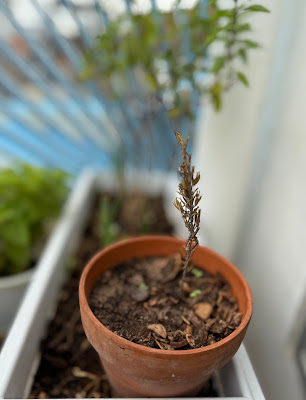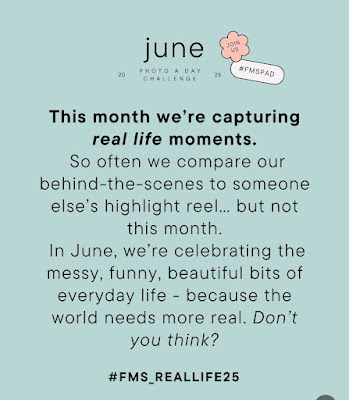JUNE 1st THE MESS I’M IGNORING: The unfortunate truth about coastal regions in developing countries
Second choice
JUNE 2nd I FORGOT I OWNED THIS: tiny, Japanese, ceramic frog you keep in your purse or wallet. The Japanese believe if it’s in your purse it will never be empty. I realized I no longer had mine years ago and then when we were in Adelaide early this year I found it in a wallet I had left in storage with money in it!! Lucky me. Now it’s back in the purse I use everyday
* the phone tool is for scale
JUNE 3rd ACCIDENTAL ART: When an oil spot on the asphalt is turned into art by the monsoon rain. We saw hundreds of these colour spectrum splashes today
 |
JUNE 4th SHOULDN’T BE HERE: One of these shouldn’t be here. They are a “bungchu” or traditional Bhutanese food container. They are brand new and meant to be a matching pair which snap together to make a carrier and can be used separately as plates to eat from. It wasn’t until we reached home that I realised these two were different patterns. I guess there is therefore the opposite pair in the handicraft market in Thimphu still now
JUNE 5th SOMETHING IN MY JUNK DRAWER: I don’t actually have a junk drawer but anything without a home usually ends up in a basket or in this drawer where I found a fabric dye I must have bought 5 years ago for a project I have long forgotten. Does it have an expiry date I wonder?
JUNE 6th THE LAUNDRY I IGNORED: firstly because the limited line space on the balcony was already full of sheets and towels and then because of the torrential monsoon rains
JUNE 7th SOCK THAT LOST ITS PARTNER: I can honestly say that it’s never happened to me. I have only pairs and so instead this is the sock box that lives in the wardrobe as I almost never wear socks here in the tropics anyway
JUNE 8th SOMETHING SUSS: Nothing would tempt me to enter a restaurant with this sitting in plain view on the footpath out the front. What do they use it for? Why would you want to advertise that as an ingredient? Very suss
JUNE 9th WHERE MY KEYS SHOULD BE: I have two very different sets of keys. These for our cottage in Australia and those I use daily here. This is a case of where my key should be! These live in this bag with various items required in Australia but the last time I went the key to our storage unit which has always been with this set had mysteriously evaporated. We changed the lock but I still wonder where it went
JUNE 10th RANDOM FRIDGE ITEM: An “atsara”magnet from Bhutan on the fridge door, holding entrance tickets a few favourite places we have been in recent times. Atsaras are not just jesters; they are storytellers, master of ceremonies, and play a crucial role in both entertaining the crowd and encouraging spiritual reflection at Tshechu
JUNE 11th WHAT’S IN MY POCKET?: If I actually have a pocket, it’s usually just my phone but that’s what I take photos with so only my hand. And why is it that women’s clothes so rarely have pockets anyway?
JUNE 12th MAKES NO SENSE: This is apparently Eurler’s formula. It makes no sense to me. Although it was carefully explained in the riveting book (“The Housekeeper and the Professor” by Yoko Ogawa) I borrowed this morning and just finished, as usual all things mathematical seem beyond me
JUNE 13th OOPSIE DAISY: This is now the third attempt at growing a rosemary in the tropics- one purchased as a plant grown locally and two from cuttings from different sources. I guess it’s just not a goer for our little balcony garden. At least the three varieties of basil, spring onions, chillies and Indian borage thrive. Count your blessings
JUNE 14th AN OBJECT OUT OF PLACE: This beautiful property had absolute Mekong River frontage for decades, so the pontoon was in regular use, but now that land reclamation has created an artificial island, the pontoon is redundant and the remaining strip of river is becoming overgrown with water hyacinths without the river flow and boating activities. The price of development …..
JUNE 15th FOUND IT LIKE THIS: We started a little micro-greens garden just four days ago and I found it looking like this fist thing this morning
JUNE 16th BAD HAIR DAY: for me it means drag it all off my face and tie it back
JUNE 17th A SNACK I DIDN'T SHARE: A homemade muesli cookie made by me yesterday and this one was devoured with coffee after a cleaning frenzy this morning
JUNE 18th SMELLS WEIRD: to me at least. Plenty of people love durian and it’s quite expensive even here but it’s is an undeniably weird smell. So much so that in many Asian countries there are restrictions about carrying it on public transport or consuming it in hotel rooms! I’ve never tried it myself, due to the smell when it’s cut open: hence the one I photographed
*the evidence at a bus station
JUNE 19th A PLANT THAT'S TRYING: These little snake plants or mother-in-laws tongues, which ever name you know them by, are battling fully immersed in water to reach the light. We already have so many but given that they are the number one filters of pollutants in the air, I continue to propagate more and find little niches for them or gift them to friends
JUNE 20th WHAT I SHOULD BE DOING: is reinstating the dining table, chairs, spirit house and terrace garden now that the new, veranda roof has been installed but given that it’s early evening and it has taken all day we are going out to dinner and leaving that task until tomorrow
* this one was selected for the Notable Nine on Facebook
JUNE 21st A PET JUDGING ME: Not actually a pet but a stairwell cat that is alway unimpressed with people in its proximity. I call him Mr Evil Eye
JUNE 22nd TOO MANY MUGS: Not sure why we have this many mugs but as someone disinclined to waste anything, I seem to be a hopeless hoarder in pursuit of second uses for all manner of things. I also derive incredible pleasure from finding an odd new purposes for said objects
JUNE 23rd A FRIDGE MAGNET: The one and only interesting fridge magnet in our house has already been posted this month so the rest are purely practical to display the responses to my snail mail project and other images I find interesting. This one I found and it is the street from which we enter our apartment in the year that I was born so it lives permanent in the display while others come and go
JUNE 24th THE WEIRDEST THING IN MY HOUSE: Coke! I drink it once a decade or less and only when I don’t feel well. So that’s how today panned out
JUNE 25th A MASTERPIECE (SARCASM): I was stumped by this prompt but then walked by this as we often do. As a sculpture this is hideous and given that this gorgeous building has quite recently been renovated after years of standing in near decrepitude, I simple cannot understand why it wasn’t the first thing demolished
JUNE 26th UNREAD BOOKS THAT DESERVE BETTER: This is a bookshop in Battambang where we arrived this morning. I think I have stepped into it every one of the now eight times I have been here and usually there are no customers. Today there was. But not one person was interested in this shelf and when I yet again perused the titles neither was I. Perhaps some of them had been there since my first visit in 2013
JUNE 27th WHO PUT THIS HERE?: Why it’s there I get. The fruit is often foraged from the street trees but I’ve never seen it bagged for protection except on private properties until today
JUNE 28th CHAOTIC CORNER: We never fail to attend a Phare Circus performance when in Battambang and tonight’s very somber but incredibly moving show was a demanding physical portrayal of the most chaotic corner of Khmer history. “Rouge” derived from the the Pol Pot era of the Khmer Rouge was a visual and percussive assault of the senses encapsulating that dark, chaotic past
JUNE 29th MY MOOD IN OBJECT FORM: I choose a cocktail. It’s Ian’s birthday and I’ve been feeling celebratory all day
JUNE 30th WHAT'S THIS EVEN FOR?: in our house it’s a wall decoration but I actually do know…..
The Yi minority women of Yunnan province in China use them to protect their backs, when they carry heavy baskets of herbs, medicinal plants, wild food and seeds foraged from the mountains
PROMPTS


































